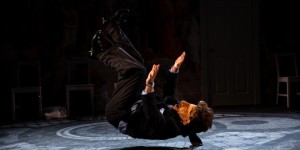IMPRESSIONS: "Posaka" Kinding Sindaw at LaMaMa, Directed and Choreographed by Potri Ranka Manis

Tradition Bearers and Music Direction: Bai Leonorah Dirampaten Grande, Lynn Buti, Sitti Aria Sangkula Askalani Obesso, Datu Faisal Monal, Nonilon V. Queaño
Martial Artist: Guro Frank Ortega
Actors and Dancers: Hamza Razuman, Margaret Marie Guzman, Brian Balayon, Vanessa Rappa, Emily Goes, Vivian Chow, Andre Igancio Dimapilis, Erno Hornillosa, Jameelah Rose Del Prado Lineses, Joseph Lineses, Diane Camino
When Potri Ranka Manis moved here from Mindanao in 1990, she brought her magic with her. A registered nurse, Manis succored victims of the AIDS epidemic by day. At night, however, she donned ancestral robes, burnt incense, and set about recovering the indigenous traditions of her people.

Kinding Sindaw, the performing arts group Manis founded, celebrated its 30th anniversary on October 20, with a vibrant concert of dance and music at LaMaMa’s Downstairs Theater. The event was titled Posaka, a word loosely translated as “heirloom.” During a pre-performance talk, however, Manis explained that “Posaka” refers to a spirit that travels from one generation to the next. In Mindanao, this spirit lives in an oral tradition of epic story-telling and genealogy; and it inhabits objects of traditional manufacture: brass daggers, musical instruments, patterned fabrics and wooden chests inlaid with mother-of-pearl. These gorgeous relics of indigenous life were on display in the Downstairs Theater lobby; and audience members were invited to inspect them and ask questions before the show.

These and similar objects also took part in the performance, where, in a mystical atmosphere sweetened by incense and prayers, the distinction between animate and inanimate beings sometimes grew vague. Already invested with the life force of their creators, these hand-crafted objects might come to seem larger-than-life, as their handlers “danced” them around the stage. Clearly the Mindanese regard these possessions as treasures, and seek to make them as beautiful as possible---how different from our disposable culture.

In an early segment of Posaka, warriors sparred in ritual combat. Would it ever be possible to separate these men from the symbols they carried---the wooden swords, whose blades they tested reverentially; the narrow shields that doubled as musical instruments rattling as the men shook them; and the fringed headdresses that concealed the warriors’ deadly gaze? No, clearly these objects were essential.
Later, a bevy of women wearing crowns on their heads entered with mincing steps. Seating themselves on the floor, these princesses anointed one another with unguents served to them on little dishes, and then retreated behind a curtain. When the women emerged, they seemed transformed into goddesses, or apsaras, by the addition of silvery finger-extensions with bangles attached. With palms stretched back and gestures curling, these women seemed to wield supernatural powers.

Manis, the company’s founder, revealed her own shamanistic powers in an episode depicting a ship at sea. This ship, a wooden toy, rested precariously on a scarf stretched in the air, threatening at every moment to overturn and sinking into deep troughs of fabric. No doubt, this vessel would have been lost, if Manis had not conjured over it.
Throughout the show, plaintive singing and humming, the rich tones of kulintang gongs and a xylophone, a mouth harp, and various kinds of drums embedded the action in a complex web of music.

Upstage, a hanging video screen offered close-ups of more “heirloom” objects, and opened a window onto life in the Philippines showing farmers, and children, and buildings devastated by earthquake. We take for granted our ability to see such images, of course, and they seem harmless to us. It may be difficult to understand that the creeping spread of modern technology represents a greater threat to the survival of indigenous cultures than any natural disaster.
Evidently, Filipinos understand old-school colonialism. The final segment of Posaka was a martial arts display showing the whole cast armed with wooden batons, and prepared to defy the next foreign invader. Clearly, they expect an army to show up, and aren’t thinking about televisions, personal computers, and the temptation to own a houseful of electronic gadgets. When their cell phones ring, however, and modernity calls with an alluring sales-pitch, chances are they will drop their defensive posture and answer.












